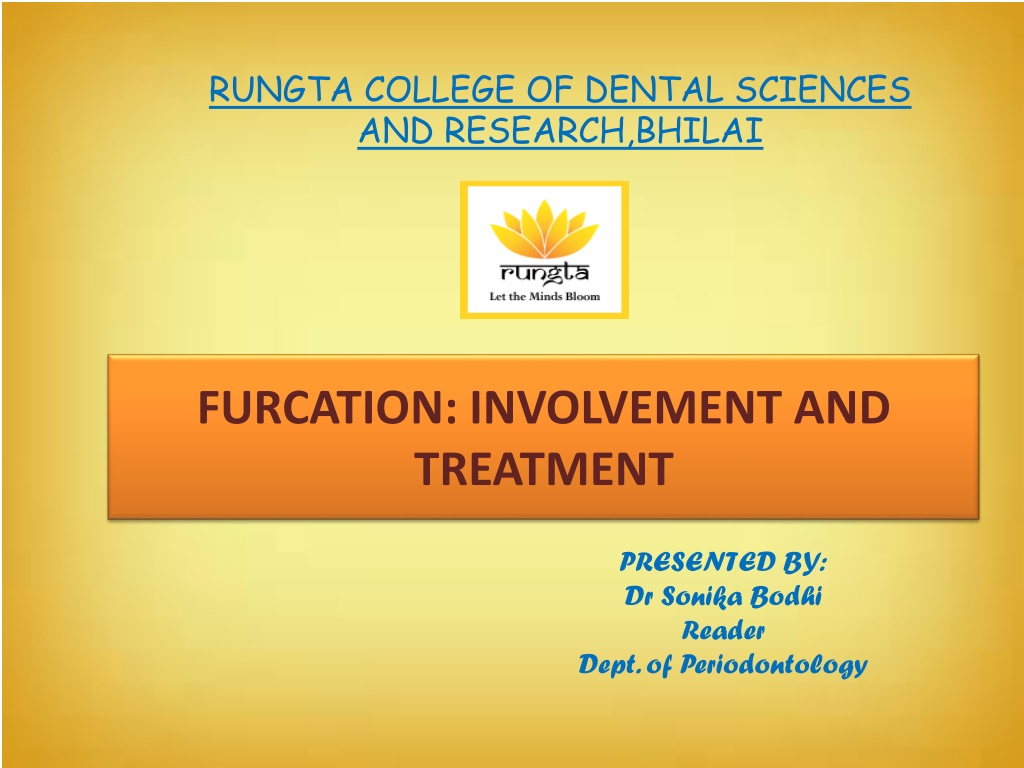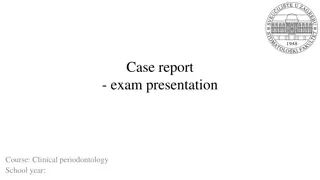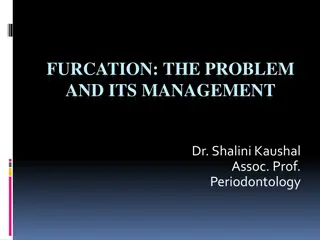
Understanding Furcation Involvement in Periodontal Disease
Furcation involvement in multirooted teeth is a critical aspect of advanced periodontitis, affecting both diagnosis and treatment outcomes. This content covers the definition, classification, etiological factors, and treatment options for furcation involvement in dental patients. Local anatomic factors and bacterial plaque play crucial roles in the progression of periodontal disease in the furcation area, making it challenging to manage effectively. Familiarizing oneself with the complexities of furcation involvement can aid in providing better care for patients with advanced periodontal issues.
Download Presentation

Please find below an Image/Link to download the presentation.
The content on the website is provided AS IS for your information and personal use only. It may not be sold, licensed, or shared on other websites without obtaining consent from the author. Download presentation by click this link. If you encounter any issues during the download, it is possible that the publisher has removed the file from their server.
E N D
Presentation Transcript
RUNGTA COLLEGE OF DENTAL SCIENCES AND RESEARCH,BHILAI FURCATION: INVOLVEMENT AND TREATMENT PRESENTED BY: Dr Sonika Bodhi Reader Dept. of Periodontology
SPECIFIC LEARNING OBJECTIVES CORE AREAS DOMIN Affective CATEGORY Desire to know Introduction Cognitive Must to know Definition Cognitive Must to know Classification Cognitive Nice to know Etiological factors Cognitive Must to know Treatment
CONTENTS INTRODUCTION DEFINITION CLASSIFICATION ETIOLOGICAL FACTORS TREATMENT CONCLUSION
INTRODUCTION The presence of furcation involvement is one clinical finding that can lead to a diagnosis of advanced periodontitis and potentially to a less favorable prognosis for the affected tooth or teeth. Furcation involvement therefore presents both diagnostic and therapeutic dilemmas.
DEFINITION The FURCATION is an area of complex anatomic morphology that may be difficult or impossible to debride by routine periodontal instrumentation. FURCATION INVOLVEMENT invasion of the bifurcations/ trifurcations of multirooted tooth by periodontal disease.
CLASSIFICATION GLICKMAN IN 1953 GRADE I GRADE II GRADE III GRADE IV
ETIOLOGIC FACTORS Bacterial plaque and the inflammatory consequences that result from its long-term presence. Local anatomic factors (e.g., root trunk length, root morphology) Local developmental anomalies (e.g., cervical enamel projections).
LOCAL ANATOMIC FACTORS ROOT TRUNK LENGTH distance from the cementoenamel junction to the entrance of the furcation . short root trunks may be more accessible to maintenance procedures, and may facilitate some surgical procedures. Alternatively, long root trunks or fused roots ....difficult to treat.
ROOT LENGTH Teeth with long roots and short to moderate root trunk length are more readily treated because sufficient attachment remains to meet functional demands.
ROOT FORM Interradicular Dimension fused roots...difficult Teeth with widely separated roots...more readily treated.
ANATOMY OF FURCATION The presence of bifurcational ridges, a concavity in the dome, accessory canals.....complicates treatment and periodontal maintenance. Odontoplasty to reduce or eliminate these ridges may be required during surgical therapy for an optimal result.
CERVICAL ENAMEL PROJECTIONS ...Masters and Hoskins in 1964 Grade I: The enamel projection extends from the cementoenamel junction of the tooth toward the furcation entrance. Grade II: The enamel projection approaches the entrance to the furcation. It does not enter the furcation, and therefore no horizontal component is present. Grade III: The enamel projection extends horizontally into the furcation
PATTERN OF ATTACHMENT LOSS Horizontal bone loss can expose the furcation as thin facial/lingual plates of bone that may be totally lost during resorption. Alternatively, areas with thickened bony ledges may persist and predispose to the development of furcations with deep vertical components
PATTERN OF ATTACHMENT LOSS Complex multiwalled defects with deep, interradicular vertical components may be candidates for regenerative therapies. Alternatively, molars with advanced attachment loss on only one root may be treated by resective procedures .
TREATMENT Objectives: (1) to facilitate maintenance, (2) to prevent further attachment loss, and (3)to obliterate the furcation defects as a periodontal maintenance problem. The selection of therapeutic mode varies with the class of furcation involvement, the extent and configuration of bone loss, and other anatomic factors.
Therapeutic Classes of Furcation Defects Class I: Early Defects conservative periodontal therapy. Because the pocket is suprabony and has not entered the furcation, oral hygiene, scaling, and root planing are effective. Any thick overhanging margins of restorations, facial grooves, or CEPs should be eliminated by odontoplasty, recontouring, or replacement.
Class II Shallow horizontal involvement without significant vertical bone loss usually responds favorably to localized flap procedures with odontoplasty and osteoplasty. Isolated deep class II furcations may respond to flap procedures with osteoplasty and odontoplasty. This reduces the dome of the furcation and alters gingival contours to facilitate the patient s plaque removal
Classes II to IV: Advanced Defects Nonsurgical treatment is usually ineffective because the ability to instrument the tooth surfaces adequately is compromised. Periodontal surgery, endodontic therapy, and restoration of the tooth may be required to retain the tooth.
SURGICAL THERAPY ROOT RESECTION indicated in grade II to IV furcation involvements. may be performed on vital teeth or endodontically treated teeth.
Indications and contraindications for root resection ........by Bassaraba 1. Teeth that are of critical importance to the overall dental treatment plan. Examples: abutment Teeth
2. Teeth that have sufficient attachment remaining for function. Molars with advanced bone loss in the interproximal and interradicular zones, unless the lesions have three bony walls, are not candidates for root amputation.
3. Teeth for which a more predictable or cost-effective method of therapy is not available. Examples are teeth with furcation defects that have been treated successfully with endodontics but now present with a vertical root fracture, advanced bone loss, or caries on bone root.
4. Teeth in patients with good oral hygiene and low activity for caries are suitable for root resection.
Which Root to Remove....?? Remove the root(s) that will eliminate the furcation and allow the production of a maintainable architecture on the remaining roots.
Remove the root with the greatest amount of bone and attachment loss. X Teeth with uniform advanced horizontal bone loss are not suitable for root resection. Remove the root that best contributes to the elimination of periodontal problems on adjacent teeth.
Remove the root with the greatest number of anatomic problems, such as severe curvature, developmental grooves, root flutings, or accessory and multiple root canals. Remove the root that least complicates future periodontal maintenance.
HEMISECTION splitting of a two-rooted tooth into two separate portions. Bicuspidization or separation .....because it changes the molar into two separate roots. most likely to be performed on mandibular molars with buccal and lingual class II or III furcation involvements.
RECONSTRUCTION deep two-walled or significant three-walled components. These vertical bony deformities respond favorably to a variety of other surgical procedures, including debridement with or without membranes and bone grafts.
EXTRACTION The extraction of teeth with through-and-through furcation defects (classes III and IV) and advanced attachment loss.
SUMMARY The keys to long-term success appear to be thorough diagnosis, selection of patients with good oral hygiene, and careful surgical and restorative management.
REFERENCES Newman MG, Takei HH, Klokkevold PR, Carranza FA. Carranza s clinical periodontology, 10th ed. Saunders Elsevier; 2007. Lindhe J, Lang NP and Karring T. Clinical Periodontology and Implant Dentistry. 6th ed. Oxford (UK): Blackwell Publishing Ltd.; 2015. Newman MG, Takei HH, Klokkevold PR, Carranza FA. Carranza s clinical periodontology, 13th ed. Saunders Elsevier; 2018.


